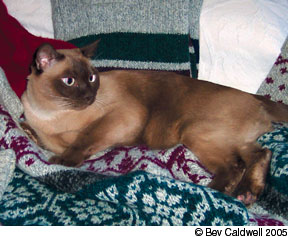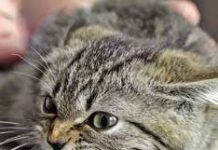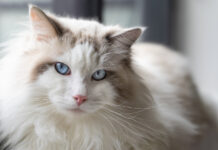Cats astound us with their grace and agility. They often amaze us with their antics. But some cats can also annoy us with their bad habits. One mystifying behavior is chewing wool and other fabrics. Wool chewing is one aspect of a complex set of behaviors called pica (pie-ka), in which a cat may target the owners personal belongings or other materials for dinner. Pica is the ingestion of non-food items, says Michelle Bamberger, MS, DVM, owner of Vet Behavior Consults in Ithaca, New York.

288
Non-food items may include your favorite wool sweater, clothing and blankets made of other fabrics, shower curtains, telephone cords, electrical cords, pantyhose or other inedible materials. Wool chewing may be sporadic or hunger-related, or it may be anxiety-related, like other forms of self-destructive behavior such as excessive licking or tail chasing. If the cat is doing it all the time, and its difficult to interrupt, the wool chewing is a compulsive disorder, says Dr. Bamberger.
The exact causes of wool chewing are unclear, but culprits may include genetic predisposition, anxiety, and environmental factors like boredom, diet or early weaning. A cat may misdirect nursing behavior to another cat or to a person, then generalize the behavior to anything soft and furry like Mom. It may be related to early weaning, but early-weaned cats dont always develop this behavior, says Dr. Bamberger.
Wool sucking presents itself when the cat is about a year to a year-and-a-half old, as opposed to most other behavior problems, which occur in four- to five-year-old cats. Approximately five percent of cats presented for behavior problems engage in wool chewing or sucking. Oriental breeds such as the Siamese seem to be more prone to it than other breeds or the general cat population.
Fixing the Problem
Obviously, wool chewing harms the garment, but it can also harm a cat. Its a signal that something is wrong, says Dr. Bamberger. If a cat ingests the material on which hes chewing, the material can ball up in his stomach or get caught in the intestines, requiring surgical removal. If he chews on electrical cords, he can electrocute himself.
If your cat engages in wool chewing, a trip to the veterinarian is the first step. Monitor your cats eating habits to be sure that the non-food item has not become the diet of choice. Be very aware if your cat stops eating, says Dr. Bamberger.
Your veterinarian may recommend increasing the fiber in your cats diet to help alleviate the problem. The cat may be chewing on non-food items to get more fiber, says Dr. Bamberger.
Putting a tablespoon of mashed pumpkin in his food or providing a flower pot of grass may help. Give your cat something else to chew on, like a pot of grass or catnip, says Dr. Bamberger.
Keep clothing and wool materials out of your cats reach. Tie up electrical cords and make them inaccessible.
If anything in your environment has changed, the wool chewing may be stress-related. Cats respond to stress in an emotional way, says Dr. Bamberger. Stressors may include grief at the loss of a feline or human companion, the addition of a person or pet to the household, or any type of household upheaval, like moving. Because stress from boredom may factor into the causes of wool chewing, enrich your cats environment with lots of toys and climbing structures to keep your pet stimulated. Your cat is a hunter at heart, so place treats in out-of-the-way places for your cat to find. Hide a few toys around the house for your cat to prey on when you arent home. And help your cat expend his excess energy by engaging in lots of interactive games. Fishing-pole toys with small swatches of fabric that mimic an insect in flight can get any felines predatory juices flowing. Simply becoming more involved in your cats day will help him work through his anxieties.
If these tips dont help, your veterinarian may recommend an anti-obsessional medication, on either a short-term or long-term basis, depending on your cat and the outcome of treatment.



